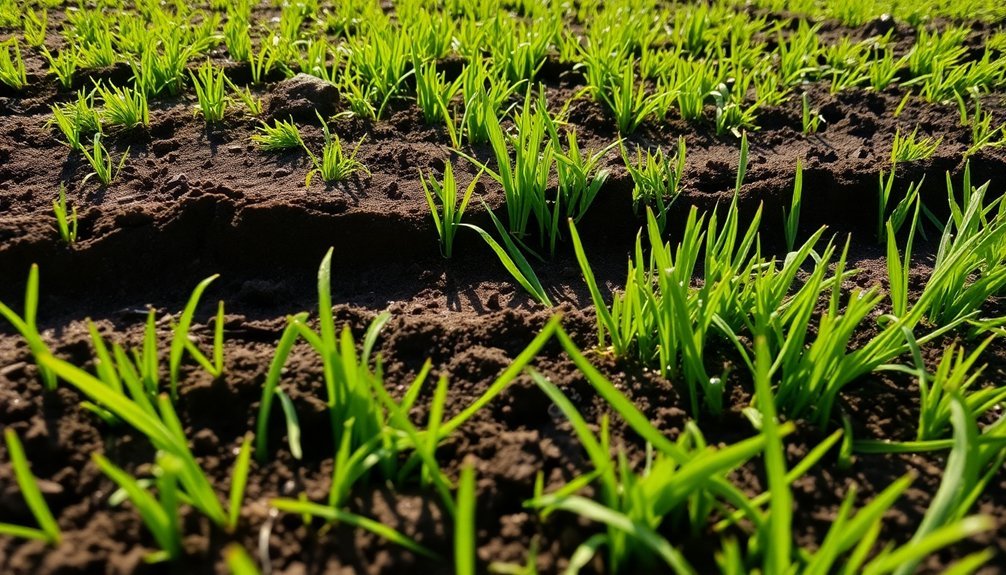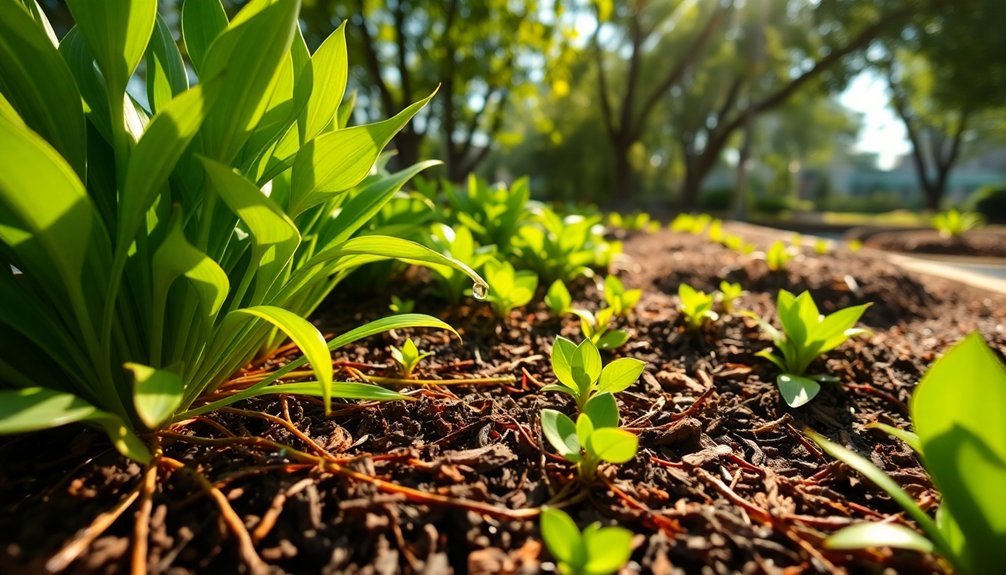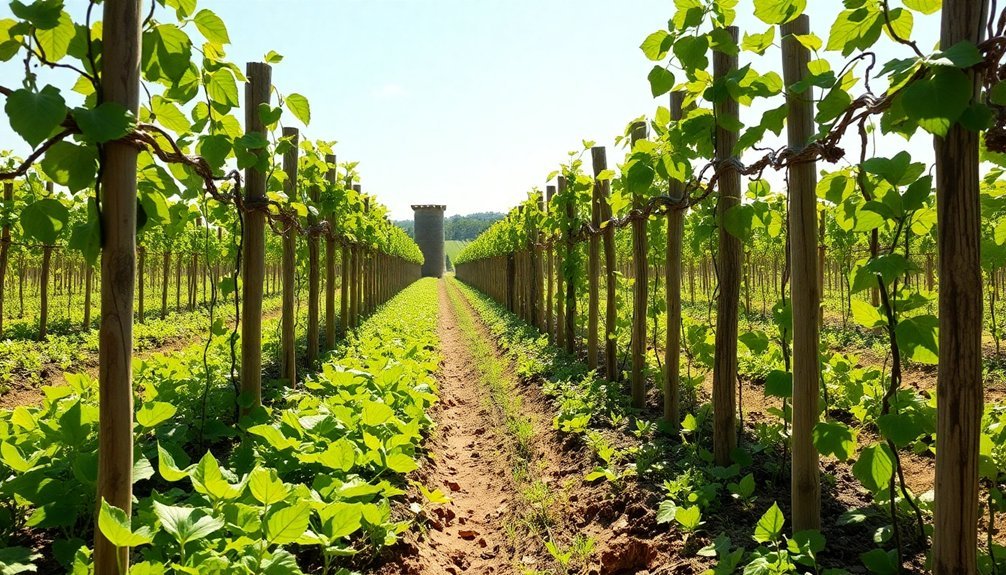Smart hedge techniques save money through strategic plant selection, proper timing, and efficient maintenance. You'll reduce costs by choosing low-maintenance varieties like Portuguese Laurel or Green Giant Arborvitae that need less water and pruning. Bulk purchasing with neighbors can save 30-50%, while proper soil management minimizes long-term expenses. Implementing water conservation strategies and investing in quality tools further maximizes your investment. The right approach transforms hedges from ongoing expenses into valuable assets.
Selecting Cost-Effective Hedge Species

When selecting hedge species for your property, it's crucial to balance initial costs against long-term maintenance requirements.
Portuguese Laurel offers excellent value with its year-round dense foliage and minimal maintenance needs, while also providing drought tolerance and deer resistance.
Consider Schip Laurel for its remarkable adaptability to various soil types and light conditions, reducing expenses on soil amendments and special care.
Schip Laurel thrives almost anywhere, saving you money on specialized soil products and complicated care routines.
It's also pollution-tolerant, making it ideal for urban settings.
Western Red Cedar and Thuja Plicata deserve attention for their natural pest resistance and soil adaptability, minimizing the need for chemical treatments.
If you're looking for rapid growth with less frequent pruning, Sweet Viburnum creates an effective screen quickly.
For drought-prone areas, established Photinia reduces water costs while providing attractive red foliage after trimming.
Green Giant Arborvitae is an exceptional choice growing 3-5 feet per year in ideal conditions, providing quick privacy with minimal maintenance requirements.
Proper Timing for Economic Planting
You'll maximize your hedging success by planting during seasonal market lows when suppliers often discount inventory.
Timing your hedge investments to coincide with interest rate adjustments can greatly reduce your long-term maintenance costs. Research shows that early planting can maximize yield potential without requiring additional fertilizer investments, especially in fields with lower fertility levels.
Strategic planting during economic stability windows helps you avoid the premium prices that typically emerge during financial uncertainty or environmental crises.
Seasonal Market Cycles
Just as farmers monitor weather patterns before planting crops, savvy investors track seasonal market cycles to optimize their financial decisions. Understanding these cycles can help you time investments and hedge against predictable fluctuations.
Markets follow natural rhythms similar to seasons: spring (growth), summer (wealth), fall (decline), and winter (scarcity). Your investment approach should adapt to each phase. During expansion phases, you'll want growth-oriented positions, while contraction periods call for defensive strategies. Planning ahead is crucial as you should prepare for upcoming seasonal changes during economic summer when business is booming.
Commodity markets show particularly strong seasonal trends—grain prices typically drop during harvest and rise in scarcity periods. Retail stocks surge during holiday seasons but often slump afterward.
Interest Rate Impacts
Interest rates function as the economic climate for your investment garden, determining what'll thrive and what may wither. When rates shift, you'll need to adjust your hedging strategy accordingly, as timing is everything in this economic landscape.
- Monitor Fed signals – The Federal Reserve telegraphs rate changes months in advance, giving you time to position your investments.
- Implement gradual hedges – Don't wait until rates spike; stagger your protection using swaps or caps.
- Balance bond exposure – Rising rates devalue existing bonds, so shorten duration when hikes are imminent.
- Adjust investment horizons – Higher rates typically slow economic growth within 12-18 months, affecting stocks. Rapid increases in rates can disrupt market stability and potentially trigger economic recession without allowing businesses sufficient time to adapt.
Crisis Avoidance Windows
While weather forecasters predict storms, savvy investors recognize economic crisis patterns and position themselves accordingly.
You'll gain significant advantages by timing your financial moves strategically during potential economic downturns.
Early intervention is essential—when you spot initial signs of market instability, deploy protective measures before full crisis emergence. Rather than seeking perfect timing, focus on executing consistently with your hedging strategy to build protection over time.
This approach mirrors successful IDA Crisis Response Window strategies, which allocate $500 million specifically for early responses.
You're not just reacting; you're preventing deeper losses.
DIY Hedge Preparation Methods
Before establishing a beautiful hedge that will thrive for years, proper preparation forms the foundation for success.
The foundation of a thriving, beautiful hedge lies in meticulous preparation and planning.
You'll save money and guarantee healthier growth by handling the groundwork correctly. Start by clearing the area of weeds and digging a trench twice as wide as your plant's root ball to encourage root expansion. Applying Rootgrow treatment to roots before planting significantly improves nutrient absorption and establishment.
- Soil preparation – Mix organic compost into your soil to improve structure and provide essential nutrients for young plants.
- Plant selection – Choose species suited to your local climate that match your maintenance availability.
- Planting technique – Position root balls carefully and pack soil firmly around roots without compacting too much.
- Post-planting care – Apply mulch immediately after planting and establish a consistent watering schedule during the first growing season.
Bulk Purchasing Advantages for Plants

You'll find significant cost benefits when buying hedging plants during off-peak seasons, often saving 30-50% on regular prices.
Partnering with neighbors or community groups can amplify your purchasing power, enabling access to wholesale pricing typically reserved for landscaping companies. Bulk purchasing not only reduces per-unit costs but also ensures steady supply availability throughout your landscaping project timeline.
These economies of scale not only reduce your per-plant costs but also minimize packaging waste and delivery expenses across your entire hedge project.
Seasonal Discount Strategies
Strategic timing of plant purchases can dramatically reduce costs while ensuring healthy inventory levels throughout the year.
By leveraging seasonal pricing fluctuations, you'll maximize your gardening budget while maintaining a vibrant landscape. Off-season purchasing often yields significant savings, especially when combined with bulk orders. These volume discounts incentivize larger purchases, allowing you to stock up for the entire growing season at reduced prices.
- Winter discounts – Purchase deciduous trees and shrubs during dormant months when nurseries offer clearance prices to reduce winter inventory.
- End-of-season sales – Buy perennials in late summer when garden centers slash prices by 30-50%.
- Holiday promotions – Take advantage of major holiday sales events like Black Friday for gardening tools and supplies.
- Pre-season planning – Order spring plants in winter months when suppliers offer early-bird specials to secure inventory.
Group Buying Power
Beyond individual seasonal discounts lies a powerful cost-saving approach: collective purchasing.
You'll find significant advantages when joining a garden club or neighborhood group to make bulk plant purchases. By pooling your orders with others, you'll secure lower prices that suppliers typically reserve for large commercial customers.
This collective negotiation can reduce your costs by 15-30% while simplifying procurement processes. You'll also gain access to premium varieties and resources usually unavailable to individual buyers. Your garden club membership offers immediate cost savings within weeks after your first group order.
The consolidated shipping further reduces expenses, often eliminating delivery fees entirely. This approach creates predictable costs for your landscaping projects and shields you from market fluctuations.
Plus, the relationships formed with suppliers through group purchasing often lead to preferential treatment and first access to limited stock.
Economies of Scale
When purchasing plants in large quantities, you'll access significant cost advantages through economies of scale.
Bulk buying allows you to spread fixed costs across more units, dramatically reducing the price per plant. This strategy mirrors how manufacturers and retailers optimize their operations to maximize profits while offering competitive pricing. These practices are essential for competitive positioning in both commercial and residential landscaping projects.
- Lower unit costs – Suppliers offer discounts of 15-30% when you order plants in bulk, similar to how agricultural producers reduce transaction costs.
- Streamlined delivery – Single shipments reduce transportation expenses and paperwork.
- Negotiating power – Larger orders give you leverage to request better quality or specialized varieties.
- Resource efficiency – Bulk purchases enable more efficient allocation of your gardening resources, from soil to fertilizers.
Soil Management to Reduce Long-Term Expenses

Effective soil management forms the cornerstone of sustainable farming economics. By implementing practices like crop rotation and cover cropping, you'll maintain soil fertility while preventing erosion—a major source of long-term financial drain.
Integrating techniques such as composting and natural fertilizers markedly reduces your dependence on expensive synthetic inputs. These approaches not only cut immediate costs but improve soil structure over time, leading to increased yields and greater profitability. Understanding your cost per unit of production helps identify where soil management practices are delivering the greatest returns.
Technology can amplify these benefits. Precision agriculture tools and soil analysis software help you apply resources exactly where needed, eliminating waste. Smart irrigation systems optimize water usage based on real-time conditions.
The economic equation is compelling: initial investment in sustainable soil practices yields substantial returns through reduced operational costs, enhanced productivity, and greater resilience to climate challenges.
Spacing Optimization for Material Savings
Strategic spacing optimization represents one of the most overlooked opportunities for significant material savings in agricultural operations.
By precisely calculating the distance between plants, you'll reduce resource waste while maximizing yield potential. Small-scale farmers can significantly increase their productivity through proper space management.
- Enhanced airflow between properly spaced plants decreases fungal disease incidence, cutting fungicide costs by up to 30%
- Efficient water distribution minimizes irrigation expenses through reduced competition and better moisture retention
- Optimized nutrient accessibility lowers fertilizer requirements as plants access soil resources without excessive competition
- Simplified maintenance allows for easier weeding and pest management, reducing labor hours and herbicide use
When implemented correctly, these spacing techniques create a balanced ecosystem where each plant receives adequate resources without unnecessary material inputs, directly translating to substantial cost savings.
Natural Propagation Techniques

Beyond optimizing plant spacing, you can further reduce costs by mastering natural propagation techniques.
These methods allow you to multiply your hedge plants without purchasing new ones.
Multiply your garden's bounty through natural propagation rather than opening your wallet for new plants.
Focus on layering and hardwood cuttings during autumn to late winter. February is ideal for taking cuttings from privet, cherry laurel, and dogwood.
Place them in cool, shaded spots to encourage rooting—no special equipment or rooting hormone needed.
For difficult-to-root species like climbing roses and boxwood, try layering.
Simply pin a branch to the soil until it develops roots while remaining attached to the mother plant. This method offers higher success rates than cuttings.
Both techniques preserve genetic consistency and support biodiversity while developing your gardening skills.
Remember to maintain proper moisture and eventually transplant when roots are established.
You can create a slit in the soil with a spade and directly insert cuttings from common hedge plants like privet and willow into the ground for successful propagation.
Water Conservation Strategies for New Hedges
You'll maximize water efficiency for new hedges by installing drip irrigation systems that deliver moisture directly to root zones while minimizing runoff.
Timing your watering cycles for early morning hours reduces evaporation losses and allows plants to absorb moisture before the day's heat sets in.
Apply a 2-3 inch layer of mulch around your newly planted hedges to retain soil moisture, suppress weeds, and regulate soil temperature. This approach applies outdoor water conservation principles that significantly reduce your monthly water bills during summer months.
Drip Irrigation Systems
Three critical factors make drip irrigation systems the smartest choice for new hedge installations. They deliver water directly to plant roots, reducing evaporation and runoff by up to 50% compared to traditional sprinklers.
You'll appreciate the targeted application that prevents overwatering while promoting deeper root growth and healthier plants.
- Economic efficiency – Lower water bills through precise application and reduced consumption while protecting your landscape investment
- Easy implementation – Straightforward installation along hedge bases with regularly spaced emitters ensures balanced distribution. Set your system to water for 1-2 hours every 2-3 days for optimal root development in newly planted hedges.
- Automation benefits – Integration with timers or smart controls reduces labor and guarantees consistent watering schedules
- Environmental advantages – Minimal runoff prevents soil erosion and complements sustainable practices like rainwater harvesting
Timing Watering Cycles
While establishing a new hedge requires consistent moisture, proper timing of your watering cycles dramatically improves water efficiency and plant health. Water during early morning or late evening to minimize evaporation losses and maximize absorption.
Integrate smart controllers that adjust schedules based on weather forecasts and soil moisture readings. These systems automatically respond to rainfall events, preventing overwatering while ensuring your hedges receive precisely what they need.
Understanding evapotranspiration rates in your area helps determine ideal watering frequency. Group plants with similar moisture requirements together, and you'll avoid both under and overwatering issues.
The benefits extend beyond healthier hedges—you'll see reduced water bills, increased drought resilience, and contribute to long-term water conservation efforts in your community.
Mulching For Retention
Mulching serves as one of the most effective water conservation strategies for new hedges, creating a protective barrier that dramatically reduces evaporation from the soil surface.
You'll find your newly planted hedges establish faster and require less maintenance when properly mulched.
Apply a 2-4 inch layer of organic mulch around your hedge plants, keeping it slightly away from stems to prevent rot.
Choose materials like wood chips or bark that decompose slowly, improving soil structure while conserving moisture.
- Water savings of up to 50% by reducing evaporation and irrigation frequency
- Temperature regulation keeps roots cooler in summer, warmer in winter
- Weed suppression eliminates competition for moisture and nutrients
- Economic benefit from reduced watering needs and healthier plants
Low-Maintenance Varieties and Their Financial Benefits
Selecting the right low-maintenance hedge varieties can dramatically reduce your long-term landscaping costs while enhancing property value. Evergreens like Common Box and Photinia offer year-round appeal with minimal upkeep, directly lowering your labor costs and extending tool lifespan.
Consider Euonymus japonicus for versatility, drought-tolerant Choisya for attractive blooms, or slow-growing Thuja smaragd for dense privacy screens. These options require less pruning, fertilizer, and overall attention than traditional hedges.
You'll also benefit from reduced chemical usage and equipment wear while gaining environmental advantages. Strategically placed low-maintenance hedges can disguise unsightly areas and define boundaries without the constant care that high-maintenance varieties demand.
This smart investment improves curb appeal and property value while keeping your maintenance budget in check.
Repurposing Farm Waste as Hedge Supports

Repurposing farm waste as hedge supports represents a brilliant financial and environmental strategy that complements your low-maintenance hedge varieties.
You'll greatly reduce disposal costs while creating sturdy structures that enhance your hedgerow's growth and stability.
By embracing this circular approach, you're not just saving money—you're building resilience into your farming system:
- Use pruned branches and trimmings as natural stakes that decompose slowly, providing long-term support while returning nutrients to the soil.
- Convert composted organic waste into nutrient-rich mulch around your hedges, reducing fertilizer needs.
- Repurpose old fencing materials to create hedge frameworks that protect young plants during establishment.
- Align with sustainability certifications and potentially qualify for government incentives or grants for eco-friendly practices.
Tools and Equipment Cost Reduction Approaches
While you pursue the perfect hedgerow, your equipment choices can greatly impact both your budget and long-term maintenance costs.
Consider investing in quality pruning saws for thicker branches instead of expensive electric shears—they're more cost-effective long-term and quieter too.
Manual pruning saws deliver superior value—lasting longer, working quieter, and sparing your wallet the shock of pricey electric alternatives.
Adopt selective pruning techniques that extend your tools' lifespan by reducing unnecessary wear.
You'll save considerably by maintaining your equipment properly; regular cleaning and blade sharpening prevent costly replacements.
For infrequent trimming needs, explore multi-function tools that combine trimming and sawing capabilities.
You'll reduce your overall investment while maintaining versatility.
When scheduling maintenance, opt for bi-annual thorough trimmings rather than frequent light sessions.
This approach minimizes equipment usage while potentially incorporating growth regulators to further reduce trimming frequency and associated costs.
Frequently Asked Questions
How Do Delta Hedging Ratios Impact Portfolio Insurance Costs?
Delta hedging ratios affect your insurance costs by determining rebalancing frequency. Lower ratios for ITM options reduce transaction costs, while higher ratios for ATM options increase expenses due to more frequent adjustments needed.
Can Volatility Skew Affect the Pricing of Protective Options?
Yes, volatility skew directly affects your protective options pricing. You'll pay more for put protection when there's positive skew since OTM puts have higher implied volatility than OTM calls of similar distances.
What Tax Implications Arise From Implementing Hedging Strategies?
You'll face tax implications including ordinary income treatment for qualified hedges, documentation requirements, and timing considerations. Without proper identification, you'll risk character mismatches where gains become ordinary while losses remain capital.
How Do Monetary Policy Shifts Impact Hedging Effectiveness?
Monetary policy shifts affect your hedging effectiveness by altering interest rates, market liquidity, and volatility. They'll change the value of your hedging instruments and may require you to adjust strategies to maintain ideal protection.
When Should Collar Strategies Be Preferred Over Protective Puts?
You should prefer collar strategies over protective puts when you're seeking cost-efficient protection in moderately bullish markets, want to offset protection costs, or need predictable risk parameters without paying high upfront premiums.
In Summary
By implementing these smart hedging techniques, you'll greatly reduce both upfront and long-term costs. You're not just creating beautiful boundaries—you're making financially savvy decisions. When you choose the right species, plant at ideal times, and adopt water-efficient practices, your wallet benefits as much as your landscape. Remember, cost-effective hedging doesn't sacrifice quality; it simply maximizes your gardening investment through strategic planning and sustainable choices.





Leave a Reply